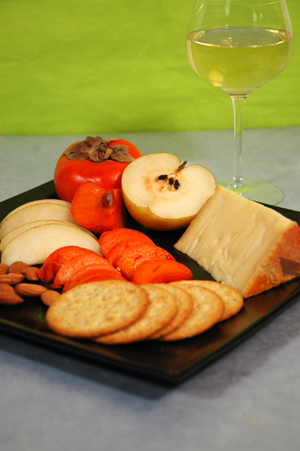

The Cheese
Allgäuer Bergkäse is the first PDO (Protected Domain of Origin) cheese from Germany to be imported into the United States. Translated as the “mountain cheese from Allgäu”, it has been made the traditional way for centuries, and is still made by hand in copper vats, one wheel at a time.
The 60-pound wheels are washed in a specific whey and brine solution (with herbs and flavorings that the makers won’t divulge!) to produce a cheese that is a cross between Emmental, Gruyere and Appenzeller. It has medium-sized holes or “eyes” distributed throughout the body of the cheese similar to, but smaller than, those in Emmental. Before being shipped to market the wheels are scraped by hand to reduce some of the intensity of the rind. Aging time is controlled on both ends; a minimum of 180 days and a maximum of 13 months.
Made exclusively from whole, raw cow’s milk produced in high mountain pastures, Allgäuer Bergkäse is quite literally the best cheese I have ever had in a fondue. It has the nuttiness of Emmental and the intensity and fruitiness of an Appenzeller or aged Gruyere. Since it was only introduced to the U.S. in September this year, it is hard to find, but for fans of full flavored Swiss-style cheeses, this one is worth seeking out. Stay tuned for the best and easiest fondue recipe you have ever used!
The Wine
Pinot Blanc is a relatively unknown grape in America, and is often confused with Chardonnay or Pinot Noir. It is genetically related to the latter, but somewhat similar in flavor to the former. This grape is planted sporadically in California and Australia, and some of the wines produced in these regions are quite wonderful. However, those thought to be Pinot Blanc in California turned out to be Melon de Bourgogne, and in Australia the vines were often mistaken for Chardonnay.
The Alto Adige region of Northern Italy produces excellent examples of Pinot Blanc. These tend to be balanced more toward the sweeter, fruity end of the spectrum, as opposed to the wines of Alsace where, in my opinion, Pinot Blanc reaches its peak. Here they produce bone-dry wines with aromas of apples, pears, persimmons and woody spices. These medium-bodied wines have bright acidity and pair well with cheeses (and food in general). The best of them can age several years, becoming quite honeyed and rich.
While I am an avid member of the ABC Club (Anything But Chardonnay), Pinot Blanc is a delightful wine that is never over-oaked and malolacticly fermented to the point of “butter and splinters,” as is typical of California Chardonnay. This wine retains a distinct freshness that draws me to it time and again.
The Extras
This pair is versatile, but shows best with an artisan seeded whole wheat bread, fresh persimmons (if you are lucky enough to be have them available), Asian pears, Macintosh apples, globe grapes and almonds (roasted and salted). Alternatives include wheat or butter crackers, seedless grapes, Fuji apples, and cashews.
Why it Works
Alsace makes the most distinctive white wines in the world, both from terroir and stylistically. The absolute dryness in the Pinot Blanc of Alsace is balanced by the richness of the Allgäuer Bergkäse, while the fruitiness of both merge and mingle on your palate. With the accompaniments listed above, this pairing offers a satisfying and fairly nutritious meal in itself!


